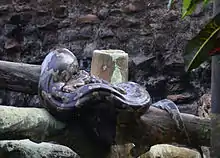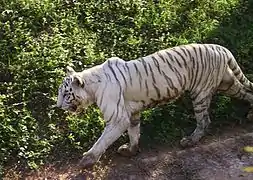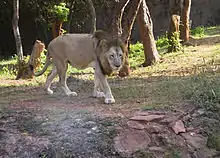Nandankanan Zoological Park
Nandankanan Zoological Park (Odia: ନନ୍ଦନକାନନ ଜୀବ ଉଦ୍ୟାନ) is a 437-hectare (1,080-acre) zoo and botanical garden in Bhubaneswar, Odisha, India. Established in 1960, it was opened to the public in 1979 and became the first zoo in India to join World Association of Zoos and Aquariums (WAZA) in 2009. It also contains a botanical garden and part of it has been declared a sanctuary. Nandankanan, literally meaning The Garden of Heaven,[1] is located near the capital city, Bhubaneswar, in the environs of the Chandaka forest, and includes the 134-acre (54 ha) Kanjia lake.
 Nandankanan Zoological Park | |
| Date opened | 29 December 1960[1] |
|---|---|
| Location | Bhubaneswar, Odisha, India |
| Coordinates | 20.399965°N 85.814703°E |
| Land area | 437 ha (1,080 acres)[2] |
| No. of animals | 3517 (2019-03-31)[3] |
| No. of species | 157 (2019)[3] |
| Annual visitors | 3.2 million (April 2018 – März 2019)[3] |
| Memberships | CZA,[4] WAZA,[5][6] SAZARC |
| Major exhibits | White Tiger Safari, Lion Safari, Butterfly Park, Orchid house |
| Website | www |
A major upgrade was done in 2000 (after the damage caused by the super-cyclone of 1999 in coastal Odisha). More than 3.2 million visitors visit Nandankanan every year.[3]
History
Forest officials decided in 1960 that including rare plants and animals in the Odisha pavilion at the World Agricultural Fair in Delhi would help increase attendance. Word was sent to the forest department to capture as many small animals as possible for the display. In all, the forest department managed to capture two spotted deer (Axis axis), two barking deer (Muntiacus muntjak), two black buck (Antilope cervicapra), one mouse deer, one leopard cat, one flying squirrel, one racket-tailed drongo, one hornbill, two parrots, two hill mynah, one peacock, and a mongoose. In addition, the divisional forest officer of Deogarh captured a pangolin (scaly ant-eater) and two porcupines, and the divisional forest officer of Puri captured a pair of wild boars and a Python. All of these animals were delivered to the Delhi fair and exhibited at the Odisha pavilion.[7]
The State Finance Department raised objections to a zoo in Odisha because of the cost of both establishing and maintaining the facility. While the issue was being debated, animals arrived back at Bhubaneswar in May 1960, posing problems to the forest department for housing and feeding them. P. Mohandra (Divisional Forest Officer, Puri) and G. K. Das (Divisional Forest Officer, Deogarh) built temporary structures at Khandagiri for the animals, and the community of Jain helped feed them. Discussions about a real zoo started soon after Dr. H. K. Mahatab, then Chief Minister of Odisha, visited the animals.[7]
The initial proposal placed the zoo at Ghatikia close to Khandagiri and Udayagiri caves. However, this was deemed to pose water problems in the future. A zoo needs lot of water to meet the need of animals, cleaning of animals sheds and for various other purposes. The then Range Officer, Chandaka suggested Jujhagarh forest block on Kanjia lake near Barang Railway station as the most ideal location. The then Chief Conservator of Forests, Divisional Forest Officer, Puri, Range Officer, Chandaka and D.P. Ghosh, Forest Ranger visited the place and were impressed with its scenic beauty. Kanjia lake with its vast expanse over 125 acres low and undulating hills of Jujhagarh and Krushnanagar D.P.F.S. with lush green vegetation on both sides of the lake presented a picturesque site. Jujhagarh Forest Block had all the advantages for locating the zoo except communication from Bhubaneswar and the only approach was via Chandaka covering a distance of 38 km.
A committee consisting of Dr. Radhanath Rath, Sri G.C. Dash and Sri D.N. Choudhury, the then Minister of Forests, Secretary, Forest and the Chief Conservator of Forests, respectively, visited the place. They were very much impressed with its aesthetic beauty and recommended location of the zoo there with construction of a straight road (a distance of 14 to 15 km) from Bhubaneswar. Accordingly, it was decided to locate the Zoological Park in Jujhagarh Forest Block, Botanical garden in Krushnanagar Forest Block and develop Kanjia lake for Boating and Angling. The Director, Fisheries agreed to develop a portion of the lake for rearing various kinds of fish for visitors to see. Initially it was decided to keep spotted deer, barking deer, black bucks, wild boars, sambars, nilagai and bears in spacious enclosures. Other animals like leopard cat, mongoose, flying squirrel, porcupine, python, monkeys, hyena, jackal, civet cat, pangolin, jungle cat, parrots, mynah and other birds in suitable cages. It was decided to put efforts to capture tigers and leopards which could be exhibited in suitable cages for the time being and the suitable spacious enclosures would be built for them later on. It was also decided to raise a good flower garden and to plant important species and medicinal plants of Odisha inside proposed Botanical garden in Krushnanagar D.P.F. Eventually the site around the 134-acre (54 ha) Kanjia Lake was chosen. The lake would be developed for recreation as well. A 15-kilometre (9.3 mi) road was built to the site, and Nandankanan Biological Park was officially inaugurated on 29 December 1960, by Sri S. K. Patil, then Indian Minister of Food and Agriculture.[7]
A botanical garden was opened in 1963. The first tiger arrived at the zoo in 1964 from the Alipore Zoo in Calcutta, along with a pair of African lions, a pair of Mugger crocodiles, and a puma. The facility was renamed Nandankanan Zoological Park in 1981.[7]
In 2009 Nandankanan Zoological Park became the first zoo in India to become a member of the World Association of Zoos and Aquariums (WAZA).[5]
Animals and exhibits
The zoo is home to about 1660 individual animals representing 166 species, including 67 species of mammals, 81 species of birds, and 18 species of reptiles.[8] The death rate of animals here during the 2008–2009 fiscal year was one of the lowest in India, at 3.1% per year compared to the national average of 10%.[9][10]
Tigers
The zoo contains several Bengal tigers (Panthera tigris tigris) of several sizes, few of them white and few of them pseudo-melanistic.
Other mammals

The zoo contains several mammals other than the tigers that have enclosures out in the open. These mammals include:[11]
- Asiatic lion (Panthera leo leo)
- Indian leopard (Panthera pardus fusca)
- Asian black bear (Urus thibetanus)
- Sloth bear (Melursus ursinus)
- Indian wolf (Canis lupus pallipes)
- Striped hyena (Hyaena hyaena)
- Dhole (Cuon alpinus)
- Indian fox (Vulpes bengalensis)
- Indian jackal (Canis aureus)
- Leopard cat (Prionailurus bengalensis)
- Giraffe (Giraffa camelopardalis)
- Zebra (Equus quagga)
- Indian elephant (Elephas maximus indicus)
- Hippopotamus (Hippopotamus amphibius)
- Hog deer (Axis porcinus)
- Nilgai (Boselaphus tragocamelus)
- Chital (Axis Axis)
- Sangai (Rucervus eldii eldii)
- Blackbuck (Antilope cervicapra)
- Sambar (Rusa unicolor)
- Swamp deer (Rucervus duvaucelii)
- Four-horned antelope (Tetracerus quadricornis)
- Indian muntjac (Muntiacus muntjak)
- Mouse deer (Moschiola indica)
- Gaur (Bos gaurus)
- Indian wild boar (Sus scrofa cristatus)
- Malabar giant squirrel (Ratufa indica)
- Indian hare (Lepus nigricollis)
- Indian grey mongoose (Herpestes edwardsii)
- Chimpanzee (Pan troglodytes)
- Orungutan (Pongo pygmaeus)
- Bonnet macaque (Macaca radiata)
- Lion-tailed macaque (Macaca silenus)
- Assamese macaque (Macaca assamensis)
- Rhesus macaque (Macaca mulatta)
- Nilgiri langur (Trachypithecus johnii)
- Hamadryas baboon (Papio hamadryas)
- Tufted capuchin (Cebus apella)
- Squirrel monkey (Saimiri sciureus)
- Common marmoset (Callithrix jacchus)
- Black-tufted marmoset (Callithrix penicillata)
Aviary
The zoo has a large section dedicated to Indian and non-Indian birds, including:
- Emu (Dromaius novaehollandiae)
- Ostrich (Struthio camelus)
- Spot-billed pelican (Pelecanus philippensis)
- Great white pelican (Pelecanus onocrotalus)
- Indian bittern (Ixobrychus sinensis)
- Cattle egret (Bubulcus ibis)
- Little egret (Egretta garzetta)
- Great egret (Ardea alba)
- Median egret (Ardea intermedia)
- Grey heron (Ardea cinerea)
- Black-crowned night heron (Nycticorax nycticorax)
- Black-headed ibis (Threskiornis melanocephalus)
- Eurasian spoonbill (Platalea leucorodia)
- Asian openbill stork (Anastomus oscitans)
- Woolly-necked stork (Ciconia episcopus)
- Lesser adjutant stork (Leptoptilos javanicus)
- Painted stork (Mycteria leucocephala)
- Sarus crane (Grus antigone)
- Mandarin duck (Aix galericulata)
- Black swan (Cygnus atratus)
- Indian grey hornbill (Ocyceros birostris)
- Red junglefowl (Gallus gallus)
- Golden pheasant (Chrysolophus pictus)
- Lady Amherst's pheasant (Chrysolophus amherstiae)
- Common pheasant (Phasianus colchicus)
- Silver pheasant (Lophura nycthemera)
- Reeve's pheasant (Syrmaticus reevesii)
- Indian peafowl (Pavo cristatus)
- Brahminy kite (Haliastur indus)
- Shikra (Accipiter badius)
- Pariah kite (Milvus migrans)
- Indian vulture (Gyps indicus)
- White-backed vulture (Gyps africanus)
- Cinereous vulture (Aegypius monachus)
- Java sparrow (Lonchura oryzivora)
- Long-tailed finch (Poephila acuticauda)
- Star finch (Neochmia ruficauda)
- Zebra finch (Taeniopygia guttata)
- Society finch (Lonchura striata domestica)
- Scaly-breasted munia (Lonchura punctulata)
- Red munia (Amandava amandava)
- Black-headed munia (Lonchura atricapilla)
- Laughing dove (Spilopelia senegalensis)
- Ring-necked dove (Streptopelia capicola)
- Barbary dove (Streptopelia risoria)
- Emerald dove (Chalcophaps indica)
- Diamond dove (Geopelia cuneata)
- Spotted dove (Spilopelia chinensis)
- Asian koel (Eudynamys scolopaceus)
- Hill mynah (Gracula religiosa)
- Budgerigar (Melopsittacus undulatus)
- Fischer's lovebird (Agapornis fischer)
- Rosy-faced lovebird (Agapornis roseicollis)
- Masked lovebird (Agapornis personatus)
- Violet turaco (Musophaga violacea)
- Livingstone's turaco (Tauraco livingstonii)
- Rainbow lorikeet (Trichoglossus moluccanus)
- Sulphur-crested cockatoo (Cacatua galerita)
- White cockatoo (Cacatua alba)
- Cockatiel (Nymphicus hollandicus)
- Grey parrot (Psittacus erithacus)
- Yellow-backed lorry (Lorius garrulus)
- Alexandrine parakeet (Psittacula eupatria)
- Brown-throated parakeet (Eupsittula pertinax)
- Ring-necked parakeet (Psittacula krameri)
- Plum-headed parakeet (Psittacula cyanocephala)
- Blossom-headed parakeet (Psittacula roseata)
- Maroon-bellied parakeet (Pyrrhura frontalis)
- Red-bellied parrot (Poicephalus rufiventris)
- Meyer's parrot (Poicephalus meyeri)
- Pineapple conure (Pyrrhura molinae)
- Sun conure (Aratinga solstitialis)
- Janday parakeet (Aratinga jandaya)
- Eastern rosella (Platycercus eximius)
- Red-and-green macaw (Ara chloropterus)
Nocturnal House
The zoo has a nocturnal house for creatures that can be seen only at night or at low-lighting conditions. These animals include:
- Common palm civet (Paradoxurus hermaphroditus)
- Small Indian civet (Viverricula indica)
- Ratel (Mellivora capensis)
- Indian pangolin (Manis crassicaudata)
- Indian crested porcupine (Hystrix indica)
- Jungle cat (Felis chaus)
- Giant fruit bat (Acerodon jubatus)
- Oriental Scops owl (Otus sunia)
- Brown fish owl (Bubo zeylonensis)
- Barn owl (Tyto alba)
Reptiles
The Zoo has a Reptile House, with a cave-like entrance guarded by a life-size replica of aTyrannosaurus rex.[12] This houses the majority of the zoo's reptiles, including:
- Indian python (Python molurus)
- Reticulated python (Malayopython reticulatus)
- Burmese python (Python bivittatus)
- Yellow anaconda (Eunectes notaeus)
- Bengal monitor (Varanus bengalensis)
- Water monitor (Varanus salvator)
- King cobra (Ophiophagus hannah)
- Monocled cobra (Naja kaouthia)
- Spectacled cobra (Naja naja)
- Russell's viper (Daboia russelli)
- Common Krait (Bungarus caeruleus)
- Banded Krait (Bungarus fasciatus)
- Oriental ratsnake (Ptyas mucosa)
- Common sand boa (Eryx johnii)
- Indian tent turtle (Pangshura tentoria)
- Indian softshell turtle (Nilssonia gangetica)
- Indian flapshell turtle (Lissemys punctata)
- Indian narrow-headed softshell turtle (Chitra indica)
- Starred tortoise (Geochelone elegans)
- Green iguana (Iguana iguana)
- Indian chameleon (Chamaeleo zeylanicus)
- Mugger crocodile (Crocodylus palustris)
- Saltwater crocodile (Crocodylus porosus)
- Nile crocodile (Crocodylus niloticus)
- Morelet's crocodile (Crocodylus moreletii)
- Siamese crocodile (Crocodylus siamensis)
- Dwarf caiman (Paleosuchus palpebrosus)
Other than that, all the three species of crocodilians found in India, the Mugger crocodile (Crocodylus palustris), the Saltwater crocodile (Crocodylus porosus) and the Gharial (Gavialis gangeticus) have their own separate, open-air enclosures outside the Reptile House.
Aquaria
The zoo includes 34 aquaria which are home to a large variety of fresh-water fish
Orchid house
The zoo will have the largest Orchid House of Odisha soon spreading over 5,000 square feet (460 m2). In Odisha alone, 130 species of orchids have been documented to date.[13]
Breeding programs
The zoo enjoys a good reputation internationally for successfully breeding black panthers, gharials, and white tigers in captivity.[11]
White tigers

Three white tigers were born in the Nandankanan Zoo in Bhubaneswar, Odisha, India in 1980. Their parents were an orange father–daughter pair called Deepak and Ganga, who were not related to Mohan or any other captive white tiger. One of their wild-caught ancestors would have carried the recessive white gene, and it showed up when Deepak was mated to his daughter. Deepak's sister also turned out to be a white gene carrier. These white tigers are therefore referred to as the Odisha strain, as opposed to the Rewa strain, of white tigers founded by Mohan.[14][15][16][17][18]
When the surprise birth of three white cubs occurred there was a white tigress already living at the zoo, named Diana, from the Delhi Zoo. One of the three was later bred to her creating another blend of two unrelated strains of white tigers. This lineage resulted in several white tigers in Nandankanan Zoo. Today the Nandankanan Zoo has the largest collection of white tigers in India. The Cincinnati Zoo acquired two female white tigers from the Nandankanan Zoo, in the hopes of establishing a line of pure-Bengal white tigers in America, but they never got a male, and didn't receive authorization from the Association of Zoos and Aquariums (AZA)'s Species Survival Plan (SSP) to breed them. The Zoo Outreach Organisation used to publish studbooks for white tigers, which were compiled by A.K. Roychoudhury of the Bose Institute in Calcutta, and subsidized by the Humane Society of India.[19] The Columbus Zoo had also hoped to breed pure-Bengal white tigers, but were unable to obtain a white registered Bengal mate for Rewati from India.[20]
There were also surprise births of white tigers in the Asian Circus, in India, to parents not known to have been white gene carriers, or heterozygotes, and not known to have any relationship to any other white tiger strains. There was a female white cub born at Mysore Zoo in 1984, from orange parents, descended from Deepak's sister. The white cub's grandmother, Thara, came from the Nandankanan Zoo in 1972. Mysore Zoo had a second female white tiger cub from New Delhi Zoo in 1984. On 29 August 1979, a white tigress named Seema was dispatched to Kanpur Zoo to be bred to Badal, a tiger who was a fourth generation descendant of Mohan and Begum. The pair did not breed so it was decided to pair Seema with one of two wild-caught, notorious man-eaters, either Sheru or Titu, from the Jim Corbett National Park. Seema and Sheru produced a white cub, and for a while, it was thought there might be white genes in Corbett's population of tigers, but the cub didn't stay white.[21][22]
There have been other cases of white tiger, white lion, and white panther cubs being born, and then changing to normal colour. White tigers which were a mixture of the Rewa and Odisha strains, born at the Nandankanan Zoo, were non-inbred. A white tiger from out of the Odisha strain found its way to the Western Plains Zoo in Australia. Australia's Dreamworld, on the Gold Coast, wanted to breed this tiger to one of their white tigers from the United States.
Crocodilians

Captive breeding units of all the three crocodilian species have been established at Nandankanan Zoo.[23] In 1980, the gharial (Gavialis gangeticus) was bred in captivity for the first time at the Nandankanan Biological Park in Odisha. This successful effort involved the collaboration and coordination between international and national zoological parks. The male came from the Frankfurt zoo and the females were from the Nandankanan and Trivandrum zoos. A large part of the credit for this first time ex-situ breeding in captivity goes to the meticulous planning and designing of the breeding enclosure at the Nandankanan Zoo by Dr. H. R. Bustard, which simulates the gharial's natural habitat of a deep flowing river with adequate high-rise sandbanks. The breeding enclosure, together with a judicious mix of adult size classes to form a social group, minimal disturbance and provision of natural food culminated in that success story, which continues to the present date. The Nandankanan Biological park has since provided many zoos around the world with captive-bred gharials for display and education.[24] Muggers bred at Nandankanan Zoo have also been released in Satkosia Gorge.
Pangolins
The zoo was the first in India to successfully breed pangolin. In a programme started before the Central Zoo Authority (CZA) pangolin breeding programme, the zoo authorities started the programme in the nocturnal centre of the animal park. There are 10 pangolins in Nandankanan Zoo, including six females.[25]
Adopt-an-Animal programme

To help involve the general public in animal conservation and raise money, the zoo started the Adopt-an-Animal programme in 2008 for all of its animals.[26][27] Adopters receive a customized adoption certificate and one free entry ticket for each animal adopted. In addition, the adopter's name is displayed on a special board and a special mention made in the annual report of the zoo.[28] Adopters can pay from ₹500 for a small bird to ₹100,000 for a tiger for a year. The zoo authorities have made available two of the most attractive sites for adoption which are the Lion Safari and Tiger Safari for which the adoption cost is ₹1,000,000 and ₹500,000 respectively. Although other zoos also have adoption programs, Nandankanan was the first zoo to get a tax exemption under section 80G of the Income Tax Act.[29] Funds received under the program are used to support the zoo's care and services for all its inhabitants by providing quality food to meet their nutritional requirements, medical care, equipment, enclosure upgrades, and biodiversity enrichment. The parents of two students Sristi and Prakriti from Cuttack were the first to adopt, paying ₹4,000 to adopt a blue and yellow macaw.[30] The State Bank of India donated ₹500,000 to adopt six endangered animals including a one-horned rhinoceros, white Bengal tiger, chimpanzee, and an orangutan.[31] The Confidence Factory, near Bhubaneswar, adopted a Royal Bengal Tigress Rebati in 2012.[32][33]
Gallery
 The Royal Bengal Tiger
The Royal Bengal Tiger Bengal Tiger at Nandankanan
Bengal Tiger at Nandankanan Emu at Nandankanan
Emu at Nandankanan Gharial at Nandankanan
Gharial at Nandankanan Hippo at Nandankanan
Hippo at Nandankanan Monitor Lizard at Nandankanan
Monitor Lizard at Nandankanan Giraffe at Nandankanan
Giraffe at Nandankanan Leopard
Leopard Tortoise
Tortoise Orangutan
Orangutan Ring Rose Parrot
Ring Rose Parrot Crocodile
Crocodile Python
Python mandarin duck (Aix galericulata)
mandarin duck (Aix galericulata) Langoor
Langoor
References
- "Nandankanan Zoo". travelchacha.com. travelChaCha. Retrieved 17 April 2011.
- "Nandankanan Biological Park". zandavisitor.com. Zoo and Aquarium Visitor. Retrieved 17 April 2011.
- "Nandankanan Zoo Annual Report 2018-19" (PDF).
- "Search Establishment". cza.nic.in. CZA. Retrieved 2 July 2011.
- "Nandankanan now a member of world zoo body". worldzootoday.com. World Zoo Today. 4 July 2009. Archived from the original on 10 March 2012. Retrieved 17 April 2011.
- "Zoos and Aquariums of the World". waza.org. WAZA. Retrieved 12 April 2011.
- "History". nandankanan.org. Nandankanan. Archived from the original on 2 February 2011. Retrieved 17 April 2011.
- Odisha Government Portal. Odisha.gov.in. Retrieved on 30 October 2016.
- "Nandankanan Zoo". thehindubusinessline.com. The Hindu Business Line. 1 February 2011. Retrieved 17 April 2011.
- "Orissa's Nandankanan Zoo recorded lowest mortality rate in India". orissadiary.com. OrissaDiary.com. 26 May 2009. Archived from the original on 25 July 2011. Retrieved 17 April 2011.
- "Nandankanan Zoo". khordha.nic.in. Khorda. Retrieved 17 April 2011.
- "Multiple funding sources to help further develop various tourist attractions and infrastructure in the coastal areas". Telegraph.
- "Nandankanan to have State's largest orchid house". The New Indian Express. Retrieved 6 May 2015.
- Roychoudhury, A.K. (1987) Chapter 34 "White Tigers And Their Conservation", Part IV "White Tiger Politics", Tigers Of The World, The Biology, Biopolitics, Management And Conservation Of An Endangered Species, Noyes Publications, Park Ridge, New Jersey USA
- Roychoudhury, A.K., & L.N. Acharjyo (1983). "Origin of white tigers at Nandankanan Biological Park, Orissa". Indian J. Exp. Biol. 21 (6): 350–52. PMID 6667990.CS1 maint: multiple names: authors list (link)
- Roychoudhury, A.K. (1990). "A Genetic Analysis Of The White Tigers In The Nandankanan Bio Park, Orissa". Journal of the Bombay Natural History Society.
- Roychoudhury A.K. "White tigers of Nandankanan lineage". Zoos' Print Journal. 4 (3): 12–3.
- Rai, Usha (15 March 1987) "Will they outlast this century?" Times of India, New Delhi
- Roychoudhury A.K. (1989). "About studbook of white tigers in India". Zoos' Print Journal. 4: 8–9.
- Ferguson, David A., & Kohl, Steven G. (1987) Developing International Conservation Programs, Tigers Of The World, Noyes Publications Park Ridge, New Jersey USA
- Roychoudhury, A.K. (1989) The Indian White Tiger Studbook, Zoo Zen, International Zoo Outreach Org., Tamil Nadu, India
- The first captive-bred white tigers. zoopros.com
- Crocodile Conservation. wildlifeorissa.in
- Ex-Situ conservation – Crocodile Breeding in Indian Zoos BC Choudhury. wii.gov.in
- "Nandankanan Zoo records first captive-bred pango". The New Indian Express. Retrieved 6 May 2015.
- "Nandankanan Zoo to start Adopt-an-Animal scheme soon". orissadiary.com. OrissaDiary.com. 23 March 2008. Archived from the original on 25 July 2011. Retrieved 17 April 2011.
- "Adoption of animals begins in Nandankanan zoo". The Hindu. Chennai, India. 22 October 2008. Retrieved 17 April 2011.
- "Nandankanan offers for adoption of inmates". Orissa.in. Orissa Network. Retrieved 17 April 2011.
- "Adopt an Animal, Get Tax Relief" (PDF). india.gov.in. Government of India. Retrieved 17 April 2011.
- "Nandankanan Zoo launches adopt-an-animal scheme". The Hindu. Chennai, India. 25 October 2008. Retrieved 17 April 2011.
- "SBI adopts animals of Nandankanan Zoo". mynews.in. MyNews. 18 November 2008. Archived from the original on 11 September 2012. Retrieved 17 April 2011.
- Singha, Minati (23 July 2012). "Private company adopts tigress at Nandankanan Zoological Park". indiatimes.com. The Times of India. Retrieved 20 January 2013.
- "Adopt an animal". 2014. Retrieved 3 August 2016.
External links
| Wikimedia Commons has media related to Nandankanan Zoological Park. |